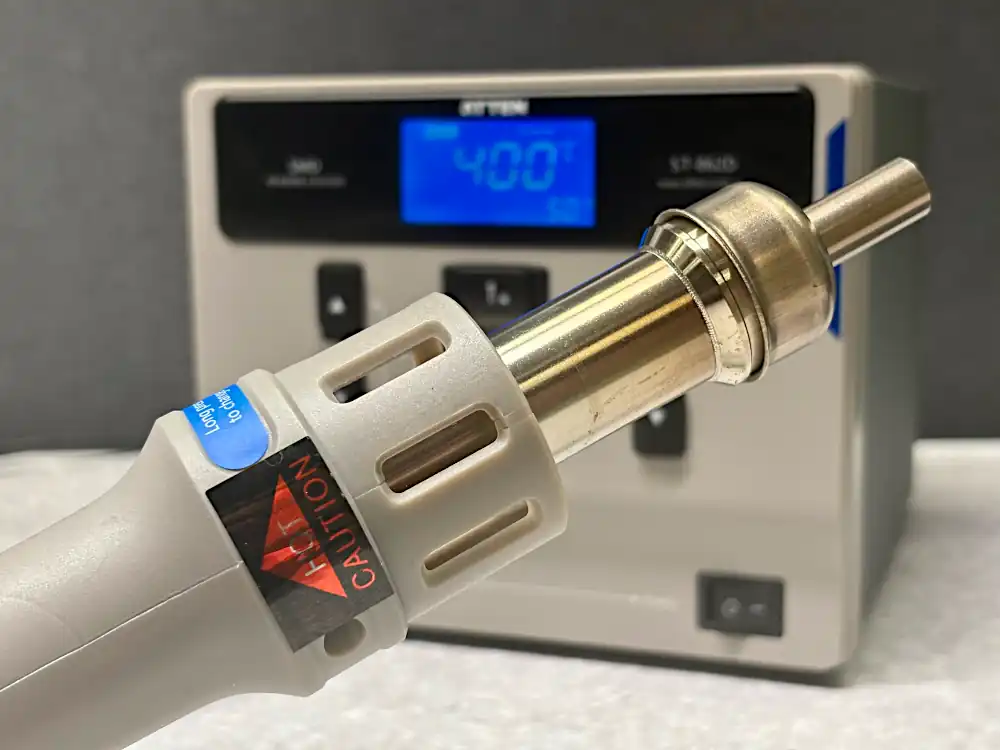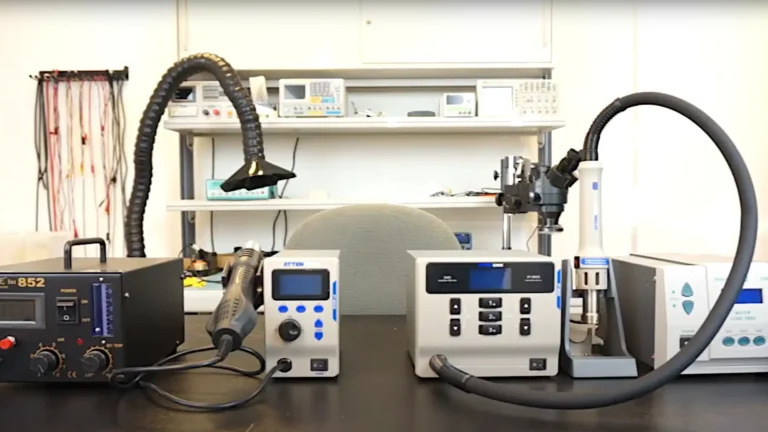Kuumailmajuotin – elektroniikkakorjaajan paras työkalu
Miksi jokaisen elektroniikkakorjaajan kannattaa hankkia kuumailmajuotin?
Kun nykyaikaiset elektroniikkalaitteet menevät rikki, tarvitaan työkaluja joilla saadaan vaativimmatkin komponentit irrotettua ja juotettua takaisin piirikortille aiheuttamatta muuta vahinkoa. Yksi korjaustyöpisteen tärkeimmistä työkaluista on kuumailmajuotin. Tässä artikkelissa käyn läpi kuumailmajuottimen hyödyt ja miten sitä käytetään oikein.
Mikä on kuumailmajuotin?
Kuumailmajuotin puhaltaa lämpötilalta ja puhallusvoimakkuudelta säädeltyä, kuumaa ilmaa, jonka avulla juote sulaa ilman suoraa kosketusta. Eri kokoisilla ja muotoisilla suuttimilla voidaan säätää ilmavirran aluetta. Toisin kuin kolvi, joka lämmittää ja sulattaa juotteen suoran kontaktin kautta, kuumailmajuotin lämmittää komponentin, juotteen ja sen ympäristön tasaisesti.
Halpamalli vai ammattilaisen asema?
Kuumailmajuottimet maksavat noin 150 eurosta jopa 2000 euroon saakka. Hintaero johtuu seuraavista ominaisuuksista:
- Edulliset asemat (esimerkiksi Atten ST-862D): Pienikokoisia ja tehokkaita, sopivat mainiosti harrastajille ja huoltotyöhön.
- Ammattilaistason asemat: Tarkempi lämpötilansäätö, ohjelmoitavat profiilit, parempi ergonomia ja laajempi valikoima suuttimia ja lisäosia.
Useimpiin korjaustöihin riittää hyvin edullinen malli.
Miksi kuumailmajuotin on ylivertainen juotostyökalu?
Kuumailmajuotosasema tarjoaa useita etuja verrattuna tavalliseen kolviin:
- Ei suoraa kontaktia juotokseen: Ei aiheuta mekaanista voimaa juotokseen, juotospädeihin eikä komponenttiin.
- Turvallinen herkille komponenteille: Vähentää lämpöshokin riskiä, joka voi rikkoa keraamiset kondensaattorit.
- Tasainen lämmitys laajemmalta alueelta: Aktivoi juoksutteen kauttaaltaan ja varmistaa siistin lopputuloksen.
- Välttämätön pohjasta juotettujen komponenttien korjauksessa: Esimerkiksi BGA- ja QFN-komponentit edellyttävät kuumailmajuotinta.
- Komponentteja voidaan irrottaa myös puhaltamalla piirikortin vastakkaiselta puolelta: Jos haluat irrottaa esimerkiksi muovirunkoisen liitimen sulattamatta liittimen muovirunkoa, voit puhaltaa liittimen juotosalueita kuumailmajuottimelta piirikortin vastakkaiselta puolelta ja tällä konstilla sulattaa juotokset.
Näin käytät kuumailmajuotosasemaa oikein
1. Valitse oikea lämpötila ja ilmavirta
Perinteisestä juotoskolvista poiketen, suoran kontaktin puuttuessa kuumailmajuotin vaatii korkeampaa asetuslämpötilaa.
- 380–420°C useimmille SMD-komponenteille.
- 350°C tai vähemmän herkille komponenteille..
- Säädä ilmavirran voimakkuus komponentille sopivaksi:
- Matala ilmavirta: Pienet komponentit (emme halua puhaltaa komponentteja pois kortilta).
- Keskinkertainen ilmavirta: Normaalit IC-piirit ym.
- Korkea ilmavirta: Isot komponentit jotka vaativat enemmän lämpöä.
2. Käytä aina fluksia
- Lisää geelimäistä fluksia juotettavan alueen päälle.
- Geelimäinen fluksi pysyy paremmin paikallaan eikä roisku pitkin piirikorttia.
3. Lämmitystekniikka
- Aloita puhaltaminen etäältä ja laske suutinta kohti komponenttia.
- Liikuta suutinta kevyesti pyörivin liikkein.
- Odota, että juote sulaa kunnolla ennen kuin irrotat komponentin.
4. Komponenttien irrotus ja uudelleenjuottaminen
- Irrotus: Lisää juoksutetta, lämmitä tasaisesti ja nosta komponentti pinseteillä.
- Juotos: Aseta uusi osa paikalleen, lämmitä kunnes juote sulaa, lisää juoksutetta ja kuumenna vielä kerran. Näin saat siistit ja kiiltävät liitokset.
Vältä nämä yleiset virheet
- Liian suuri ilmavirta: komponentit saattavat lentää pois paikaltaan
- Fluksin unohtaminen: heikko juottuvuus
- Liiallinen kuumennus: voi irrottaa piirilevyn kerroksia toisistaan tai vahingoittaa viereisiä komponentteja
- Komponentin repiminen ennen kuin juote on sulanut: juotospädit voivat irrota
Yhteenveto
Kuumailmajuotin tekee elektroniikkakorjauksesta tarkkaa, turvallista ja tehokasta. Vaikka budjetti sallisikin vain edullisen laitteen, se voi monessa tilanteessa päihittää kolvin, erityisesti pintaliitostöissä. Kun opit oikeat lämpötilat, käytät juoksutetta ja noudatat varovaisuutta, pääset nopeasti ammattimaiseen lopputulokseen. Muista, että oikean tekniikan oppiminen vaatii harjoittelua!








